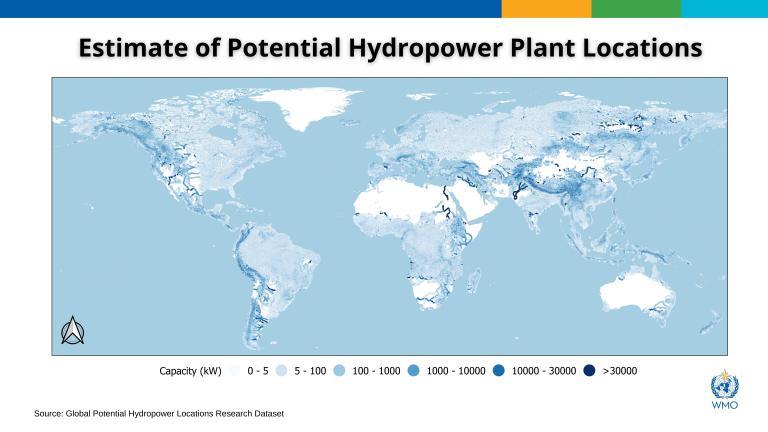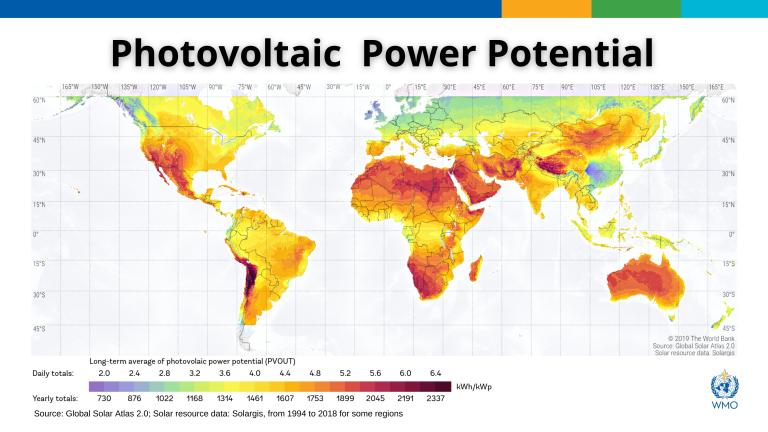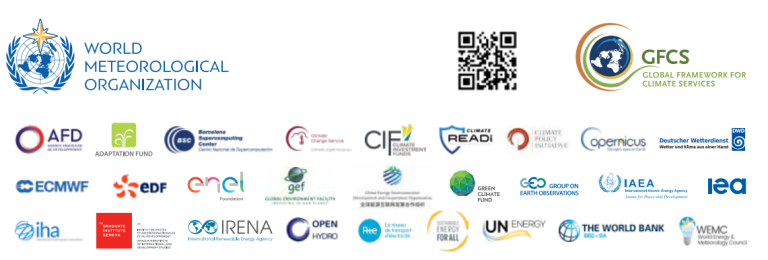Climate change puts energy security at risk
The supply of electricity from clean energy sources must double within the next eight years to limit global temperature increase. Otherwise, there is a risk that climate change, more extreme weather and water stress will undermine our energy security and even jeopardize renewable energy supplies, according to a new multi-agency report from the World Meteorological Organization (WMO).

The supply of electricity from clean energy sources must double within the next eight years to limit global temperature increase. Otherwise, there is a risk that climate change, more extreme weather and water stress will undermine our energy security and even jeopardize renewable energy supplies, according to a new multi-agency report from the World Meteorological Organization (WMO).
WMO’s State of Climate Services annual report, which includes inputs from 26 different organizations, focuses on energy this year because it holds the key to international agreements on sustainable development and climate change and, indeed, to the planet's health.
“The energy sector is the source of around three-quarters of global greenhouse gas emissions. Switching to clean forms of energy generation, such as solar, wind and hydropower – and improving energy efficiency – is vital if we are to thrive in the twenty-first century. Net zero by 2050 is the aim. But we will only get there if we double the supply of low-emissions electricity within the next eight years,” said WMO Secretary-General Prof Petteri Taalas.
“Time is not on our side, and our climate is changing before our eyes. We need a complete transformation of the global energy system,” says Prof. Taalas.
Access to reliable weather, water and climate information and services will be increasingly important to strengthen the resilience of energy infrastructure and meet rising demand (an increase of 30% in the past ten years).
The 2022 State of Climate Services: Energy report has plenty of good news. It highlights the huge opportunities for green powered grids to help tackle climate change, improve air quality, conserve water resources, protect the environment, create jobs and safeguard a better future for us all.
The report includes practical case studies.
- Early weather warnings are safeguarding energy supply in Beijing, China.
- Climate stress tests are ensuring electricity is suitably distributed in the Italian Dolomites.
- Warning systems in Tajikistan are providing advance notice of dry conditions for hydropower operations planning.
- Localized wind-resource information is aiding wind industry decision-making;
- Solar radiation measurements are supporting the placement of solar panels on noise barriers in Germany.
By 2050, global electricity needs- which will be increasing over the years being electrification a strategic lever to tackle Net Zero goals - will mainly be met with renewable energy, with solar the single largest supply source. African countries have an opportunity to seize untapped potential and be major players in the market. Africa is home to 60% of the best solar resources globally, yet with only 1% of installed photovoltaic capacity.
”We urgently need to respond to the growing impact of climate change on energy systems if we are to maintain energy security while accelerating the transition to net-zero. This requires long-term planning and bold policy action to spur investment, which in turn needs to be underpinned by comprehensive and reliable weather and climate data,” says Dr Fatih Birol, International Energy Agency Executive Director.
“Now is the time to accelerate the transition to a renewable energy future. Anything short of radical and immediate action will ultimately eliminate the chance of staying on the 1.5°C path. The intertwined energy and climate crises have dramatically exposed the weaknesses and vulnerabilities of an economic system heavily reliant on fossil fuels. Advancing the transition to renewables is a strategic choice to bring affordable energy, jobs, economic growth and a resilient environment to the people and communities on the ground,” said Francesco La Camera, IRENA’s Director-General.
More can and must be done. According to UN Secretary-General Antonio Guterres, bold climate action could deliver US$26 trillion in economic benefits by 2030. And yet, investment in renewable energy is much too low, especially in developing countries and too little attention is paid to the importance of climate services for energy to support both climate adaptation and decisions on how to reduce greenhouse gases.
WMO has issued annual reports on the state of climate services since 2019 in response to a UN request for more information on adaptation needs of countries. This year’s edition includes input from more partners than ever before. They include the International Energy Agency (IEA), International Atomic Energy Agency (IAEA), International Renewable Energy Agency (IRENA), Sustainable Energy for All (SE4ALL), UN Energy, ENEL Foundation, Adaptation Fund, Green Climate Fund (GCF), Global Environment Facility (GEF), the Copernicus Climate Change Service (C3S) and others, including private sector and civil society organizations.
“The Adaptation Fund is pleased to be a founding partner and contributor to this valuable report. The energy sector is crucial in helping curb emissions that cause climate change – at the same time, energy production itself needs to adapt to the climate impacts that are already taking place and accelerating. The Adaptation Fund funds projects that are based on the adaptation priorities of vulnerable developing countries, and we have been pleased to see an increasing number of country-driven activities that address the specific adaptation needs of the energy sector at different scales,” says Mikko Ollikainen, Head of the Adaptation Fund.
The report will be launched at a high-level event on 11 October and will also be presented to the World Energy Council summit on 13 October in Scotland. It is accompanied by an interactive digital story map.
Climate change is putting energy security at risk globally
Climate change directly affects fuel supply, energy production as well as the physical resilience of current and future energy infrastructure. Heatwaves and droughts are already putting existing energy generation under stress, making it even more important to reduce fossil fuel emissions.
The impact of more frequent and intense extreme weather, water and climate events is already clear.
For example, in January 2022, massive power outages caused by a historic heatwave in Buenos Aires, Argentina affected around 700 000 people. In November 2020, freezing rain coated power lines in the Far East of the Russian Federation, leaving hundreds of thousands of homes without electricity for several days.
Concerns about impact of global temperature increase on energy security are therefore paramount in the race to net zero emissions (NZE).
Net zero emissions are achieved when CO2 emissions from human activities are balanced globally by CO2 removals over a specified period. Net zero CO2 emissions are also referred to as carbon neutrality.
Water resources are scarce
In 2020, 87% of global electricity generated from thermal, nuclear and hydroelectric systems directly depended on water availability. Meanwhile, 33% of the thermal power plants that rely on freshwater availability for cooling are in high water stress areas. This is also the case for 15% of existing nuclear power plants, a share expected to increase to 25% in the next 20 years.
Eleven per cent of hydroelectric capacity is also located in highly water-stressed areas. And approximately 26% of existing hydropower dams and 23% of projected dams are within river basins that currently have a medium to very high risk of water scarcity.
Nuclear power plants not only depend on water for cooling but are also often located in low-lying coastal areas and hence are potentially vulnerable to sea-level rise and weather-related flooding. For example, the Turkey Point nuclear plant in Florida (United States of America), which sits at sea level, will be threatened in the coming decades. Regular improvements in operational practices and evolving regulatory obligations can substantially reduce production losses of nuclear power plants due to severe weather, according to the International Atomic Energy Authority.

Climate action plans must prioritize energy
Despite these risks, just 40% of climate action plans submitted by governments to the United Nations Framework Convention on Climate Change (UNFCCC) prioritize adaptation in the energy sector, and investment is correspondingly low.
Supply from low-emissions sources needs to double by 2030 if the world is to reach net zero by 2050, according to the report.
A transition to renewable energy will help alleviate growing global water stresses because the amount of water used to generate electricity by solar and wind is much lower than for more traditional power plants, either fossil-fuel- or nuclear-based.
But current pledges by countries fall well short of what is needed to meet the objectives set by the Paris Agreement, leaving a 70% gap in the amount of emissions reductions needed by 2030.
Renewable energy pledges represent less than half of what is needed. The pathway to reach the Paris Agreement's long-term global goal on temperature requires 7.1 TW of clean energy capacity to be installed by 2030, according to figures cited in the report.
The world is set to fall short of achieving the goal of universal access to affordable, reliable, sustainable and modern energy by 2030, as set out in SDG 7, by a wide margin.
The necessary policies and regulations to enable decarbonization in the energy sector are still particularly weak in Africa, South America and Asia, according to the World Bank. And the recognition of the need for services to support renewable energy is particularly low in Nationally Determined Contributions to the Paris Agreement.

Investments in renewables need to triple by 2050
Investments in renewable energy need to triple by 2050 to put the world on a net zero trajectory by 2050, according to figures quoted in the report. In 2019–2020, most renewable energy investments were made in the East Asia and Pacific region (mainly China and Japan), followed by Western Europe, and North America.
Developing countries are underrepresented when it comes to accessing clean energy finance.
International public financial flows to developing countries in support of clean energy and SDG 7 achievement decreased in 2019 for the second year in a row, falling to US$ 10.9 billion. This level of support was 23% lower than the US$ 14.2 billion provided in 2018, 25% lower than the 2010–2019 average, and less than half of the peak of US$ 24.7 billion in 2017.
Africa could be major renewables player
Africa is already facing severe effects from climate change, including massive droughts, despite bearing the least responsibility for the problem.
Declining clean technology costs hold new promise for Africa’s future, and there is a huge opportunity for Africa to help close the gap in the need for renewable energy. Achieving Africa’s energy and climate goals means more than doubling energy investment this decade, with a huge increase in adaptation. Only 2% of clean energy investment in the last two decades was made in Africa. Bringing access to modern energy for all Africans calls for an investment of US$ 25 billion annually, which is around 1% of global energy investment today.
Climate services provide reliable information
Renewable energy systems are weather and climate dependent, so the transition to clean energy calls for improved climate information and services to support decisions on site selection and operations, maintenance and management.
Climate services are defined as the production and delivery of relevant, credible and usable climate information. The energy industry has extensive experience using weather services. Still, it needs to do more to incorporate climate information into its decision-making to increase the resilience of energy systems to climate-related shocks and to boost energy efficiency.
There is huge room for improvement. Less than 50% of WMO Members provide tailored products for the energy sector, which shows the untapped potential of National Meteorological and Hydrological Services (NMHSs) and the efforts required to address the emerging needs of this sector.
Why do we need climate services?
Energy-sector planning and operations are affected by weather and climate variability and change. As energy systems become increasingly dependent on weather variations, it is apparent that the information flow from weather and climate data and forecasts needs to be properly incorporated into the decision support systems.
Although the power sector routinely uses weather forecasts up to 15 days, there is less experience in using climatological data.
More effective use of climate information helps scale up renewable energy infrastructure, but they will also promote clean energy system efficiency and climate resilience. Increased, sustained investments in such services, supported by recognition of the need for such services through enhanced policies, are required to achieve this.
Examples of applications of climate services for energy include:
- Planning purchases of gas and electric power;
- Managing responses in emergency situations;
- Managing capacity and resources (e.g. grid/distribution management, electricity production/pricing);
- Optimizing renewable power plant operation, especially reservoirs and hydropower operations;
In the energy sector, studies have demonstrated the economic value of very short-term, sub-seasonal and seasonal forecasts (e.g. for temperature, wind speed, stream flow) for fuel purchasing decisions, demand and generation forecasting, and system planning. Temperature forecasts allow managers to forecast peak loads more accurately and optimally schedule power generation plants to meet demands at a lower cost. Hydropower operations benefit from daily, weekly and seasonal precipitation and streamflow forecasts, which can help to optimize operations.
For example, the use of streamflow forecasts increases energy production from major Columbia River (United States) hydropower dams by 5.5 TWh/year, resulting in an average increase in annual revenue of approximately US$ 153 million per year.
Similarly, the use of forecasts to manage hydropower operations in Ethiopia produces cumulative decadal benefits ranging from US$ 1 to US$ 6.5 billion, compared to a climatological (no forecast) approach.
The development and application of targeted climate products and services through the Global Framework for Climate Services can support both adaptation and mitigation.
Notes to Editors

The World Meteorological Organization (WMO) is a specialized agency of the United Nations responsible for promoting international cooperation in atmospheric science and meteorology.
WMO monitors weather, climate, and water resources and provides support to its Members in forecasting and disaster mitigation. The organization is committed to advancing scientific knowledge and improving public safety and well-being through its work.
For further information, please contact:
- Clare Nullis WMO media officer cnullis@wmo.int +41 79 709 13 97

